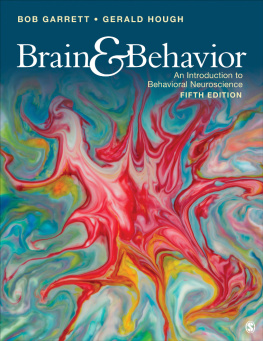
p.20
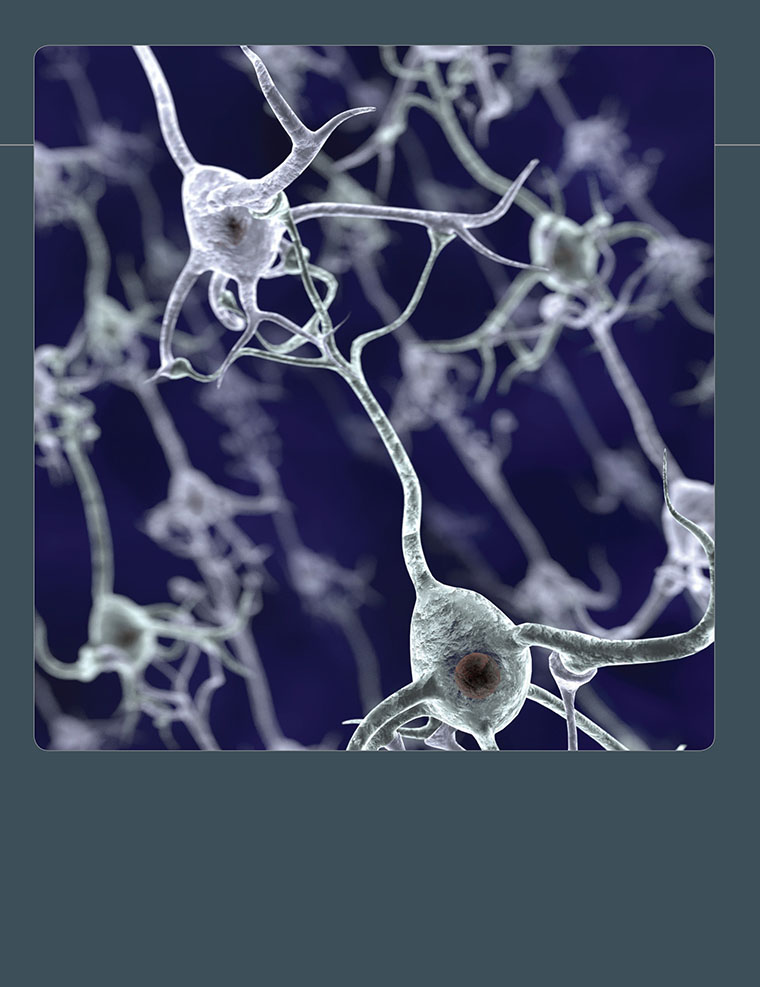
Equinox Graphics/Science Source
p.21
| Communication Within the Nervous System | 2 |
Media Library
CHAPTER 2 Media Library
PREMIUM VIDEO
ON THE WEB

Neuroscience for Kids
The Schwann Cell and Action Potential
The Origin of the Brain
The Symphony Inside Your Brain
Association for the Advancement of Artificial Intelligence
IN THE NEWS

Ramn y Cajals Work Received by New Audience
JOURNAL ARTICLE

The axonal cytoskeleton and the assembly of Nodes of Ranvier
Neuroinflammation, mast cells, and glia: Dangerous liaisons
Multiple modes of communication between neurons and oigodendrocyte precursor cells
After reading this chapter, you will be able to:
Identify the cells of the nervous system.
Name the structures of neurons.
Compare the functions of sensory, motor, and interneurons.
Explain the roles of ions and the cell membrane in nervous system communication.
Demonstrate how neurotransmitters are involved in communication between nervous system cells.
Discuss how neurons work together to generate your experiences of the world.
Illustrate the ways that excitation and inhibition are important to the functioning of the nervous system.

Master the content.
edge.sagepub.com/garrett5e
T hings were looking good for Jim and his wife. She was pregnant with their first child, and they had just purchased and moved into a new home. After the exterminating company treated the house for termites by injecting the pesticide chlordane under the concrete slab, Jim noticed that the carpet was wet and there was a chemical smell in the air. He dried the carpet with towels and thought no more about it, not realizing that chlordane can be absorbed through the skin. A few days later, he developed headaches, fatigue, and numbness. Worse, he had problems with memory, attention, and reasoning. His physician referred him to the toxicology research center of a large university medical school. His intelligence test score was normal, but the deficiencies he was reporting showed up on more specific tests of cognitive ability. Jim and his wife had to move out of their home; at work, he had to accept reduced responsibilities because of his difficulties in concentration and adapting to novel situations. The chlordane had not damaged the structure of his brain as you might suspect, but it had interfered with the functioning of the brain cells by impairing a mechanism called the sodium-potassium pump (Zillmer & Spiers, 2001). Jims unfortunate case reminds us that the nervous system is as delicate as it is intricate. Only by understanding how it works will we be able to appreciate human behavior, to enhance human performance, and to treat behavioral problems such as drug addiction and psychosis.
The Cells That Make Us Who We Are
To understand human behavior and the disorders that affect it, you must understand how the brain works. And to understand how the brain works, you must first have at least a basic understanding of the cells that carry messages back and forth in the brain and throughout the rest of the body. ; Azevedo et al., 2009). This means that there are more neurons in your brain than stars in our galaxy. But as numerous and as important as they are, neurons make up only half of the brains cells. The other half are glial cells, which we will discuss later in the chapter.
p.22
FIGURE 2.1 Estimated Numbers of Neurons in the Brain and Spinal Cord.
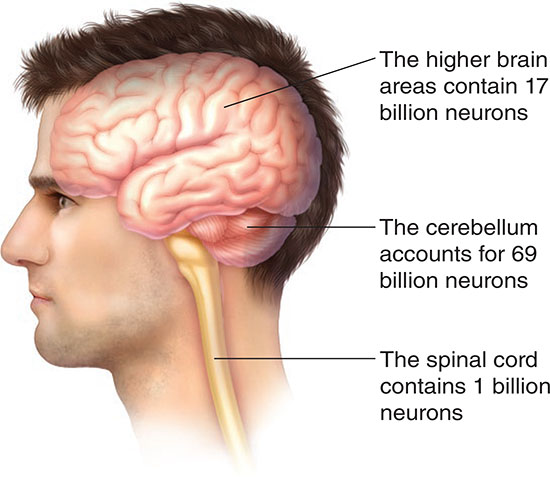
Neurons
Neurons are responsible for all the things we doour movements, our thoughts, our memories, and our emotions. It is difficult to believe that anything so simple as a cell can measure up to this task, and the burden is on the neuroscientist to demonstrate that this is true. As you will see, the neuron is deceptively simple in its action but impressively complex in its function.
Basic Structure: The Motor Neuron
First lets look inside a neuron, because we want to show you that the neuron is a cell, very much like other cells in the body. , which carries commands to the muscles and organs . It is particularly useful for demonstrating the structure and functions that all neurons have in common.

What are the parts of the neuron?
Dendrites are extensions that branch out from the cell body to receive information from other neurons . Their branching structure allows them to collect information from many neurons. The axon extends like a tail from the cell body and carries information to other locations , sometimes across great distances. The myelin sheath that is shown wrapped around the axon supports the axon and provides other benefits that we will consider later. Branches at the end of the axon culminate in swellings called axon terminals. The terminals contain chemical neurotransmitters , which the neuron releases to communicate with a muscle, an organ or the next neuron in a chain . In our examples, we will talk as if neurons form a simple chain, with one cell sending messages to a single other neuron, and so on; in actuality, a single neuron receives input from many neurons and sends its output to many others.
FIGURE 2.2 Cell Body of a Neuron.
Part of the membrane has been removed to show interior features.
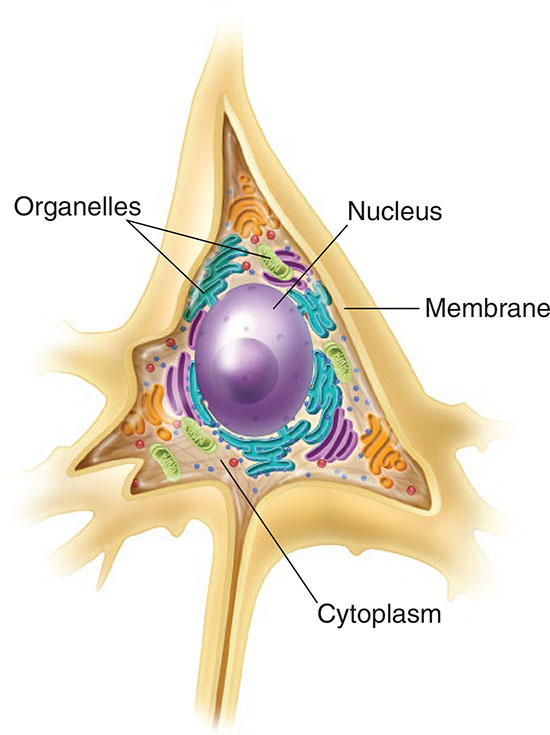
Neurons are usually so small that they can be seen only with the aid of a microscope. The cell body is the largest part of the neuron, ranging from 0.005 to 0.1 millimeter (mm) in diameter in mammals. (In case you are unfamiliar with metric measurements, a millimeter is about the thickness of a dime.) Even the giant neurons of the squid, favored by researchers for their conveniently large size, have axons that are only 1 mm in diameter. Typical axons are smaller; in mammals, they range from 0.002 to 0.02 mm in diameter. Axons may be as short as 0.1 mm or as long as 5 m in the tallest giraffes.
Other Types of Neurons
The second type of neuron is the sensory neuron. ). Motor and sensory neurons are specialized for transmission over long distances; their lengths are not shown here in the same scale as the rest of the cell.
p.23
FIGURE 2.3 Components of a Neuron.
The illustration is of a multipolar motor neuron.
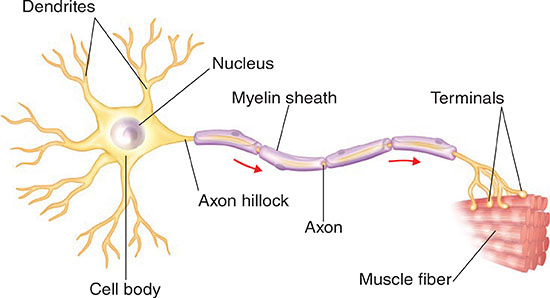
The third type is neither motor nor sensory. that this neuron is also multipolar, but its axon appears to be missing; for some interneurons this is so, and when they do have axons, they are often so short that they are indistinguishable from dendrites. Because interneurons make connections over very short distances, they do not need the long axons that characterize their motor and sensory counterparts. In the spinal cord, interneurons bridge between sensory neurons and motor neurons to produce a reflex. In the brain, they connect adjacent neurons to carry out the complex processing that the brain is noted for. Considering the major role they play, it should come as no surprise that interneurons are the most numerous neurons.
Next page
